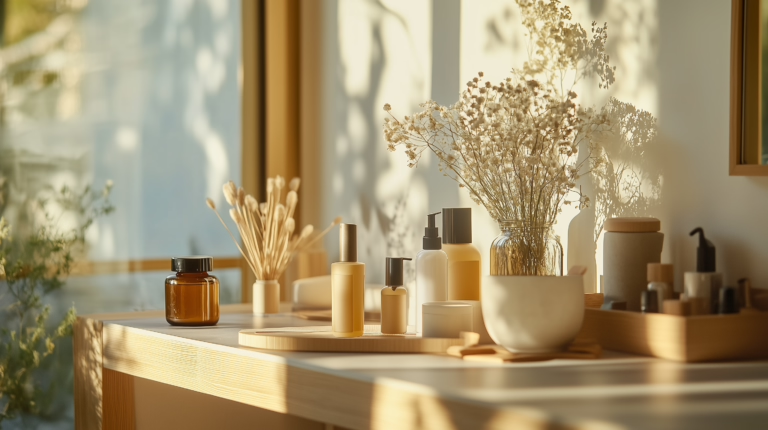9 Hair Care Tweaks: Chemical to Natural Treatments
You’ve just walked out of the salon with a fresh new color or a sleek chemical straightening—and yet your hair feels dry, brittle, or straw-like. You’re not alone. Many of us chase that perfect tone, curl-free finish, or relaxed texture without realizing the toll harsh chemicals take on our strands. The good news? You don’t have to give up your salon look forever. In this post, you’ll discover **nine simple, natural treatments** that rebuild strength, restore shine, and soothe your scalp—no sulfates, silicones, or peroxide required. Over the next few minutes, you’ll learn:
Why conventional chemicals harm your hair’s health
How ingredients like honey, hibiscus, and rice water work
Step-by-step recipes you can whip up with pantry staples
Realistic expectations for when you’ll see results
Whether you live in Mumbai, Mysore, or a small town in India, these beginner-friendly fixes fit any budget or schedule. Ready to swap harsh formulas for gentle, effective self-care? Let’s dive in.

Why Ditch Harsh Chemicals?
When you straighten, bleach, or color your hair, strong agents like sulfates, silicones, and peroxide strip away the natural oils and proteins that keep strands hydrated and flexible. Think of your hair like a cotton shirt: wash it too often in hot water, and the fibers weaken, fade, and feel scratchy. Over time, repeated chemical treatments can:
Reduce moisture retention – leading to chronic dryness
Break down keratin bonds – causing split ends and breakage
Throw off scalp pH – inviting itchiness or dandruff
Research shows that hair exposed to harsh bleaching agents can lose up to 30% of its tensile strength in a single session—and repeated exposure compounds the damage.¹
By choosing natural ingredients, you tap into centuries-old wisdom: plants and pantry staples deliver vitamins, proteins, and fatty acids in their gentlest form. Instead of masking damage with silicones (which coat the strand but don’t repair it), these treatments **penetrate**, **nourish**, and **seal** hair from the inside out. Best of all, they support long-term health—so your next salon visit starts with a stronger foundation.
9 Natural Tweaks
1. Honey-Avocado Deep-Conditioning Mask
Why it works
Honey is a humectant: it draws moisture into your hair shaft.
Avocado is rich in healthy fats and vitamin E, sealing in that hydration.
What you’ll need:
2 tbsp raw honey
½ ripe avocado, mashed
1 tbsp coconut oil (optional for extra slip)
Steps:
1. Mash avocado until smooth.
2. Stir in honey (and coconut oil, if using) to form a creamy paste.
3. Section your hair and apply mask from roots to ends.
4. Cover with a shower cap and leave on for 30–45 minutes.
5. Rinse thoroughly with lukewarm water, then shampoo lightly if needed.
Expect: – Softer, more manageable hair after one use; consistent weekly masks can reduce breakage by up to 25%.²

2. Hibiscus & Coconut Oil Rinse
Why it works:
Hibiscus – petals contain amino acids that gently strengthen and repair protein bonds.
Coconut oil – penetrates the shaft to reduce water loss and frizz.
What you’ll need:
1 handful dried hibiscus petals (or 2 fresh petals)
2 cups water
2 tbsp melted coconut oil
Steps:
1. Simmer petals in water for 10 minutes; let cool and strain.
2. Stir in coconut oil until suspended.
3. After shampooing, pour rinse slowly over hair, massaging into scalp.
4. Leave on for 5–10 minutes, then rinse lightly.
Tips: – Use once or twice weekly. Hibiscus’s natural color can tint light hair slightly—test a small section first.
3. Aloe Vera Ricotta Protein Treatment
Why it works:
Aloe vera – soothes inflammation and seals cuticles.
Ricotta cheese – delivers gentle proteins to rebuild strands without the stiffness of keratin treatments.
What you’ll need:
¼ cup fresh aloe vera gel
2 tbsp ricotta cheese
1 tsp honey (optional for moisture)
Steps:
1. Blend aloe gel and ricotta until smooth.
2. Add honey and stir.
3. Apply to damp hair, focusing on mid-lengths and ends.
4. Wrap in a warm towel for 20 minutes.
5. Rinse with cool water to close cuticles.
Caution: – Avoid if you have dairy sensitivities on your scalp. Limit to biweekly to prevent protein overload.

4. Fenugreek Seed Scalp Soother
Why it works:
Fenugreek seeds – are rich in nicotinic acid and proteins that curb inflammation and support hair growth.
Anti-fungal properties help combat dryness and itch.
What you’ll need:
– 2 tbsp fenugreek seeds
– Water to soak
– 1 tsp olive oil (optional)
Steps:
1. Soak seeds overnight in enough water to cover.
2. Blend into a paste, adding oil if desired for slip.
3. Massage gently into scalp and leave for 30 minutes.
4. Rinse thoroughly, then shampoo as usual.
Expect: – Reduced itch and flakiness within a week; continue every 7–10 days for best results.
5. Apple Cider Vinegar pH-Balancing Rinse
Why it works:
-Your scalp and hair operate best at a pH around 4.5–5.5. ACV restores this balance, sealing cuticles for extra shine.
What you’ll need:
1 part raw, unfiltered apple cider vinegar
4 parts water
2–3 drops essential oil (lavender or peppermint) to mask odor
Steps:
1. Mix ACV and water in a squeeze bottle.
2. After shampoo, pour rinse over hair, avoiding eyes.
3. Let sit for 2–3 minutes, then rinse well.
Frequency:- Every 1–2 weeks. Overuse can dry hair—stick to this schedule for scalp health and luster.

6. Shikakai & Amla Powder Cleanse
Why it works:
– Shikakai** is a natural cleanser rich in saponins, foaming gently without stripping oils.
– Amla powder** delivers vitamin C and antioxidants for strength and shine.
What you’ll need:
2 tbsp shikakai powder
1 tbsp amla powder
Warm water to form a paste
Steps:
1. Mix powders and enough water to form a thick paste.
2. Apply to wet hair like shampoo, massaging from roots to tips.
3. Leave on for 5 minutes, then rinse thoroughly.
4. Follow with a mild conditioner or any of the masks above.
Benefits: – Regular use (once a week) cleanses gently, leaving hair soft and residue-free.

7. Yogurt & Lemon Scalp Exfoliant
Why it works:
Yogurt** contains lactic acid to gently slough off dead cells.
Lemon juice** adds vitamin C and helps control oil.
What you’ll need:
¼ cup plain yogurt
1 tsp fresh lemon juice
1 tsp granulated sugar (optional for extra scrub)
Steps:
1. Stir yogurt, lemon juice, and sugar until combined.
2. Massage onto damp scalp in circular motions for 2–3 minutes.
3. Let sit 5–10 minutes, then rinse and shampoo.
Caution:- If your scalp is sensitive, skip sugar and reduce lemon to a few drops. Use once every 10–14 days.

8. Rice Water Strengthening Soak
Why it works:
Rice water is rich in inositol, a carbohydrate that repairs surface damage and improves elasticity.
What you’ll need:
– ½ cup uncooked rice
– 2 cups water
– Small pinch salt (optional for scalp circulation)
Steps:
1. Rinse rice until water runs clear.
2. Soak rice in water for 30 minutes, stirring occasionally.
3. Strain rice water into a bowl; add salt if using.
4. After shampoo, apply rice water from roots to ends, massaging gently.
5. Leave 10–20 minutes, then rinse lightly.
Tip: – For extra potency, ferment the strained water at room temperature for 24 hours before refrigerating. Use twice weekly for stronger, shinier hair.

9. Almond Oil & Lavender Overnight Serum
Why it works:
Almond oil – is rich in fatty acids and vitamin E, penetrating deeply to nourish.
Lavender oil – soothes the scalp and adds a calming scent.
What you’ll need:
2 tbsp sweet almond oil
5–6 drops lavender essential oil
Steps:
1. Warm almond oil slightly (test temperature).
2. Stir in lavender oil.
3. Apply evenly through mid-lengths and ends, avoiding all-over scalp if you’re prone to oiliness.
4. Wrap hair in a silk scarf or bonnet and sleep on a toweled pillow.
5. In the morning, shampoo and condition as usual.
Result: – Wake up to smoother, frizz-free strands and a gentle lavender aroma.
Next Steps
Switching from chemical-laden products to these natural tweaks can feel like a big leap—but remember, **small, consistent changes** yield the best results. Start by picking one or two treatments that match your most pressing concern: moisture, protein repair, scalp health, or shine. Track your progress with photos or notes every two weeks to see how your hair transforms.
Plan your first week – Choose two tweaks (e.g., honey-avocado mask on Monday, ACV rinse on Thursday).
Set realistic goals:- Notice softness or reduced breakage within 3–4 applications.
Stick to a schedule : – Overdoing protein (ricotta or fenugreek) can backfire—alternate with moisture boosts.
Your hair’s health is a journey, not a one-time fix. By blending these natural rituals with occasional salon visits, you’ll maintain that polished look **and** nurture your strands from root to tip.
Your action step: –Pick one treatment to try tonight. Share in the comments which one you chose and how your hair feels tomorrow!

Further Resources & FAQs
FAQ 1: Can I mix these treatments together?
Yes—with care. For example, you can follow a **rice water soak** with the **almond oil serum** overnight. But avoid stacking multiple protein treatments (ricotta, fenugreek) in the same week. Always test a small section first to ensure your hair responds well.
FAQ 2: How often should I use these tweaks?
Moisture treatments – (honey-avocado, ACV rinse): once a week
Protein treatments – (aloe-ricotta, fenugreek): every 10–14 days
Cleanses & exfoliations – (shikakai, yogurt scrub): once a week
Daily serum – (almond oil): 2–3 nights per week, or as needed for dryness
FAQ 3: Are these safe for colored or keratin-treated hair?
Absolutely. In fact, these gentle botanical ingredients help **extend** your color’s vibrancy and prolong keratin smoothness. Just skip any citrus-heavy treatments (lemon in yogurt scrub) for 48 hours post-color to avoid slight lightening.







